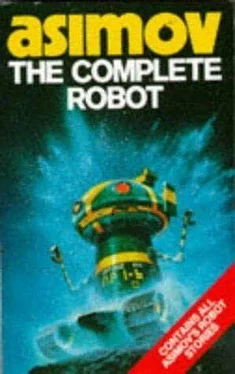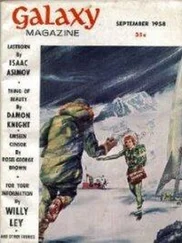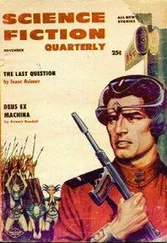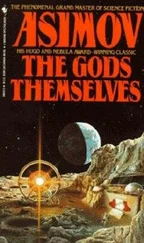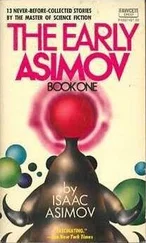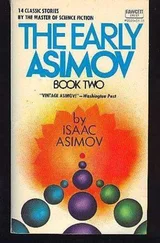Isaac Asimov - The Complete Robot
Здесь есть возможность читать онлайн «Isaac Asimov - The Complete Robot» весь текст электронной книги совершенно бесплатно (целиком полную версию без сокращений). В некоторых случаях можно слушать аудио, скачать через торрент в формате fb2 и присутствует краткое содержание. Жанр: Фантастика и фэнтези, на английском языке. Описание произведения, (предисловие) а так же отзывы посетителей доступны на портале библиотеки ЛибКат.
- Название:The Complete Robot
- Автор:
- Жанр:
- Год:неизвестен
- ISBN:нет данных
- Рейтинг книги:3 / 5. Голосов: 1
-
Избранное:Добавить в избранное
- Отзывы:
-
Ваша оценка:
- 60
- 1
- 2
- 3
- 4
- 5
The Complete Robot: краткое содержание, описание и аннотация
Предлагаем к чтению аннотацию, описание, краткое содержание или предисловие (зависит от того, что написал сам автор книги «The Complete Robot»). Если вы не нашли необходимую информацию о книге — напишите в комментариях, мы постараемся отыскать её.
The Complete Robot — читать онлайн бесплатно полную книгу (весь текст) целиком
Ниже представлен текст книги, разбитый по страницам. Система сохранения места последней прочитанной страницы, позволяет с удобством читать онлайн бесплатно книгу «The Complete Robot», без необходимости каждый раз заново искать на чём Вы остановились. Поставьте закладку, и сможете в любой момент перейти на страницу, на которой закончили чтение.
Интервал:
Закладка:
Isaac Asimov
The Complete Robot
Dedicated To:
Marjorie Goldstein
David Bearinger
Hugh O'Neill
For whom books are in progress
Introduction
By the time I was in my late teens and already a hardened science fiction reader, I had read many robot stories and found that they fell into two classes.
In the first class there was Robot-as-Menace. I don't have to explain that overmuch. Such stories were a mixture of "clank-clank" and "aarghh" and "There are some things man was not meant to know." After a while, they palled dreadfully and I couldn't stand them.
In the second class (a much smaller one) there was Robot-as-Pathos. In such stories the robots were lovable and were usually put upon by cruel human beings. These charmed me. In late 1938 two such stories hit the stands that particularly impressed me. One was a short story by Eando Binder entitled "I, Robot," about a saintly robot named Adam Link; another was a story by Lester del Rey, entitled "Helen O'Loy," that touched me with its portrayal of a robot that was everything a loyal wife should be.
When, therefore, on June 10, 1939 (yes, I do keep meticulous records), I sat down to write my first robot story, there was no question that I fully intended to write a Robot-as-Pathos story. I wrote "Robbie," about a robot nurse and a little girl and love and a prejudiced mother and a weak father and a broken heart and a tearful reunion. (It originally appeared under the title-one I hated-of "Strange Playfellow.")
But something odd happened as I wrote this first story. I managed to get the dim vision of a robot as neither Menace nor Pathos. I began to think of robots as industrial products built by matter-of-fact engineers. They were built with safety features so they weren't Menaces and they were fashioned for certain jobs so that no Pathos was necessarily involved.
As I continued to write robot stories, this notion of carefully engineered industrial robots permeated my stories more and more until the whole character of robot stories in serious printed science fiction changed-not only that of my own stories, but of just about everybody's.
That made me feel good and for many years, decades even, I went about freely admitting that I was "the father of the modern robot story."
As time went by, I made other discoveries that delighted me. I found, for instance, that when I used the word "robotics" to describe the study of robots, I was not using a word that already existed but had invented a word that had never been used before. (That was in my story "Runaround," published in 1942.)
The word has now come into general use. There are journals and books with the word in the title and it is generally known in the field that I invented the term. Don't think I'm not proud of that. There are not many people who have coined a useful scientific term, and although I did it unknowingly, I have no intention of letting anyone in the world forget it.
What's more, in "Runaround" I listed my "Three Laws of Robotics" in explicit detail for the first time, and these, too, became famous. At least, they are quoted in and out of season, in all sorts of places that have nothing primarily to do with science fiction, even in general quotation references. And people who work in the field of artificial intelligence sometimes take occasion to tell me that they think the Three Laws will serve as a good guide.
We can go even beyond that-
When I wrote my robot stories I had no thought that robots would come into existence in my lifetime. In fact, I was certain they would not, and would have wagered vast sums that they would not. (At least, I would have wagered 15 cents, which is my betting limit on sure things.)
Yet here I am, forty-three years after I wrote my first robot story, and we do have robots. Indeed, we do. What's more, they are what I envisaged them to be in a way-industrial robots, created by engineers to do specific jobs and with safety features built in. They are to be found in numerous factories, particularly in Japan, where there are automobile factories that are entirely roboticized. The assembly line in such places is "manned" by robots at every stage.
To be sure, these robots are not as intelligent as my robots are-they are not positronic; they are not even humanoid. However, they are evolving rapidly and becoming steadily more capable and versatile. Who knows where they'll be in another forty years?
One thing we can be sure of. Robots are changing the world and driving it in directions we cannot clearly foresee.
Where are these robots-in-reality coming from? The most important single source is a firm called Unimation, Inc., of Danbury, Connecticut. It is the leading manufacturer of industrial robots and is responsible for perhaps one third of all robots that have been installed. The president of the firm is Joseph F. Engelberger, who founded it in the late 1950S because he was so interested in robots that he decided to make their production his life work.
But how in the world did he become so interested in robots so early in the game? According to his own words, he grew interested in robots in the 1940s when he was a physics-major undergraduate at Columbia University, reading the robot stories of his fellow Columbian Isaac Asimov.
My goodness!
You know, I didn't write my robot stories with much in the way of ambition back in those old, old days. All I wanted was to sell them to the magazines in order to earn a few hundred dollars to help pay my college tuition-and to see my name in print besides.
If I had been writing in any other field of literature, that's all I would have attained. But because I was writing science fiction, and only because I was writing science fiction, I-without knowing it-was starting a chain of events that is changing the face of the world.
Joseph F. Engelberger, by the way, published a book in 1980 called Robotics in Practice: Management and Application of Industrial Robots (American Management Associations), and he was kind enough to invite me to write the foreword.
All this set the nice people at Doubleday to thinking-
My various robot short stories have appeared in no less than seven different collections of mine. Why should they be so separated? Since they appear to be far more important than anyone dreamed they would be (least of all, I) at the time they were written, why not pull them together in a single book?
It wasn't hard to get me to agree, so here are thirty-one short stories, totaling some 200,000 words, written over a time period stretching from 1939 to 1977-
Some Non-human Robots
I am not having the robot stories appear in the order in which they were written. Rather, I am grouping them by the nature of the contents. In this first division, for instance, I deal with robots that have a non-human shape-a dog, an automobile, a box. Why not? The industrial robots that have come into existence in reality are non-human in appearance.
The very first story, "A Boy's Best Friend," is not in any of my earlier collections. It was written on September 10, 1974-and you may find in it a distant echo of "Robbie," written thirty-five years earlier, which appears later in this volume. Don't think I'm not aware of that.
You will note, by the way, that in these three stories, the concept of Robot-as-Pathos is clearly marked. You may also notice, however, that in "Sally" there seems to be no hint of the Three Laws and that there is more than a hint of Robot-as-Menace. Well, if I want to do that once in a while, I can, I suppose. Who's there to stop me?
A Boy's Best Friend
Mr. Anderson said, "Where's Jimmy, dear?"
"Out on the crater," said Mrs. Anderson. "Hell be all right Robutt is with him.-Did he arrive?"
Читать дальшеИнтервал:
Закладка:
Похожие книги на «The Complete Robot»
Представляем Вашему вниманию похожие книги на «The Complete Robot» списком для выбора. Мы отобрали схожую по названию и смыслу литературу в надежде предоставить читателям больше вариантов отыскать новые, интересные, ещё непрочитанные произведения.
Обсуждение, отзывы о книге «The Complete Robot» и просто собственные мнения читателей. Оставьте ваши комментарии, напишите, что Вы думаете о произведении, его смысле или главных героях. Укажите что конкретно понравилось, а что нет, и почему Вы так считаете.
